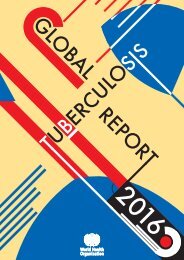patients
DNDi_AR_2015
DNDi_AR_2015
Create successful ePaper yourself
Turn your PDF publications into a flip-book with our unique Google optimized e-Paper software.
HEPATITIS C<br />
R&D MODEL & PORTFOLIO<br />
What is hepatitis C ?<br />
2.6 million children below the age of 5 living with HIV/AIDS,<br />
Hepatitis C is an inflammatory liver disease caused by infection with the hepatitis C virus<br />
more (HCV). than HCV 86% is transmitted of all new infections parenterally in sub-Saharan through exchange Africa of body fluids, mostly through<br />
exposure to contaminated blood. Most <strong>patients</strong> are unaware of their infection status and<br />
150,000 furthermore, access children to treatment under remains 15 years of beyond age died reach of AIDS-related in most developing illness countries<br />
in where 2014 the globally burden of disease is the greatest, and no vaccine is available.<br />
The incubation period for hepatitis C infection lasts from 2 weeks to 6 months.<br />
Approximately 15-20% of people clear the infection spontaneously. While they have<br />
developed HCV-specific antibodies, after a few months HCV RNA can no longer be<br />
detected in their blood. However, about 75-85 % of newly infected people develop chronic<br />
infection; HCV infects their liver cells and can cause severe inflammation of the liver with<br />
long-term complications. About 60-70% of chronically infected people develop chronic<br />
liver disease; 5-20% develop cirrhosis within the first two decades of infection and 5%<br />
liver cancer. In addition to liver disease, HCV persistent infection is associated with<br />
chronic fatigue, diabetes, depression, cryoglobulinaemia, and kidney disease.<br />
Due to the high genetic heterogeneity of HCV, it is classified into six major genotypes.<br />
Disease expression and response to therapy may vary according to the genotype.<br />
What are the current treatments and their limitations?<br />
Up until 2011, pegylated-interferon with ribavirin was the standard treatment for chronic<br />
HCV, but management of the treatment is complex and many <strong>patients</strong> do not finish their<br />
48-week treatment course because interferon is not well tolerated and can be difficult<br />
to access in some settings. Recent scientific advances have led to the development of<br />
new antiviral drugs for HCV, the direct acting antivirals (DAAs), which have revolutionized<br />
the therapeutic landscape. In recognition of this, in 2016 the WHO updated its treatment<br />
guidelines to recommend that DAA regimens be used for the treatment of people with<br />
hepatitis C infection rather than regimens with pegylated interferon and ribavirin. DAAs<br />
are much more effective (with cure rates of >95% in clinical trials, including in previously<br />
hard-to-treat populations), safer, and better tolerated than existing therapies. Their use<br />
has simplified HCV treatment by decreasing the duration of treatment, simplifying<br />
monitoring and laboratory requirements, and increasing cure rates. However, despite<br />
the low cost of production, access to these treatments remains quite limited, due mostly<br />
to the high price charged by innovator pharmaceutical companies.<br />
130-150<br />
million people<br />
globally have chronic HCV<br />
infection,<br />
of which<br />
85%<br />
live in lowand<br />
middle-income<br />
countries<br />
2.3<br />
million people<br />
suffer from HIV/HCV<br />
co-infection worldwide<br />
500,000<br />
deaths per year<br />
from HCV-related liver diseases<br />
WHAT IS DNDi DOING TO ADDRESS UNMET TREATMENT NEEDS?<br />
DNDi plans to enable the use of DAAs as a public health tool to treat HCV. A public health<br />
approach for resource-limited settings will be taken, including simplified models of care<br />
that allow for decentralization to the primary healthcare level, task shifting of clinical and<br />
non-clinical services, and reduced dependence on genotyping and other sophisticated lab<br />
monitoring.<br />
DNDi is proposing a two-step project with a focus on:<br />
1. Regional research & development<br />
(R&D):<br />
In the medium term, DNDi and partners<br />
will conduct Phase III clinical trials in<br />
Malaysia, Thailand, and other countries<br />
to test the efficacy of a combination<br />
of sofosbuvir (SOF, already registered<br />
for HCV) + ravidasvir (RDV, a promising<br />
drug candidate) as a pan-genotypic<br />
treatment and public health for tackling<br />
the HCV epidemic.<br />
2. Support affordable access:<br />
An actively engaged Advisory Group has<br />
been created to advise the project on the<br />
rapidly-changing HCV treatment access<br />
landscape. There are many avenues for<br />
access, including but not limited to:<br />
developing alternative treatments with<br />
favourable licensing/access terms, patent<br />
oppositions, compulsory licensing, and<br />
voluntary licensing. Multi-stakeholder<br />
projects will be piloted in key countries.<br />
By 2020, DNDi aims to deliver<br />
from its HCV-specific portfolio:<br />
Evidence for the safety, efficacy,<br />
and ease of use of direct-acting<br />
antiviral regimens to be used in<br />
an affordable combination as a<br />
public health approach<br />
DNDi Annual Report 2015 › 49



